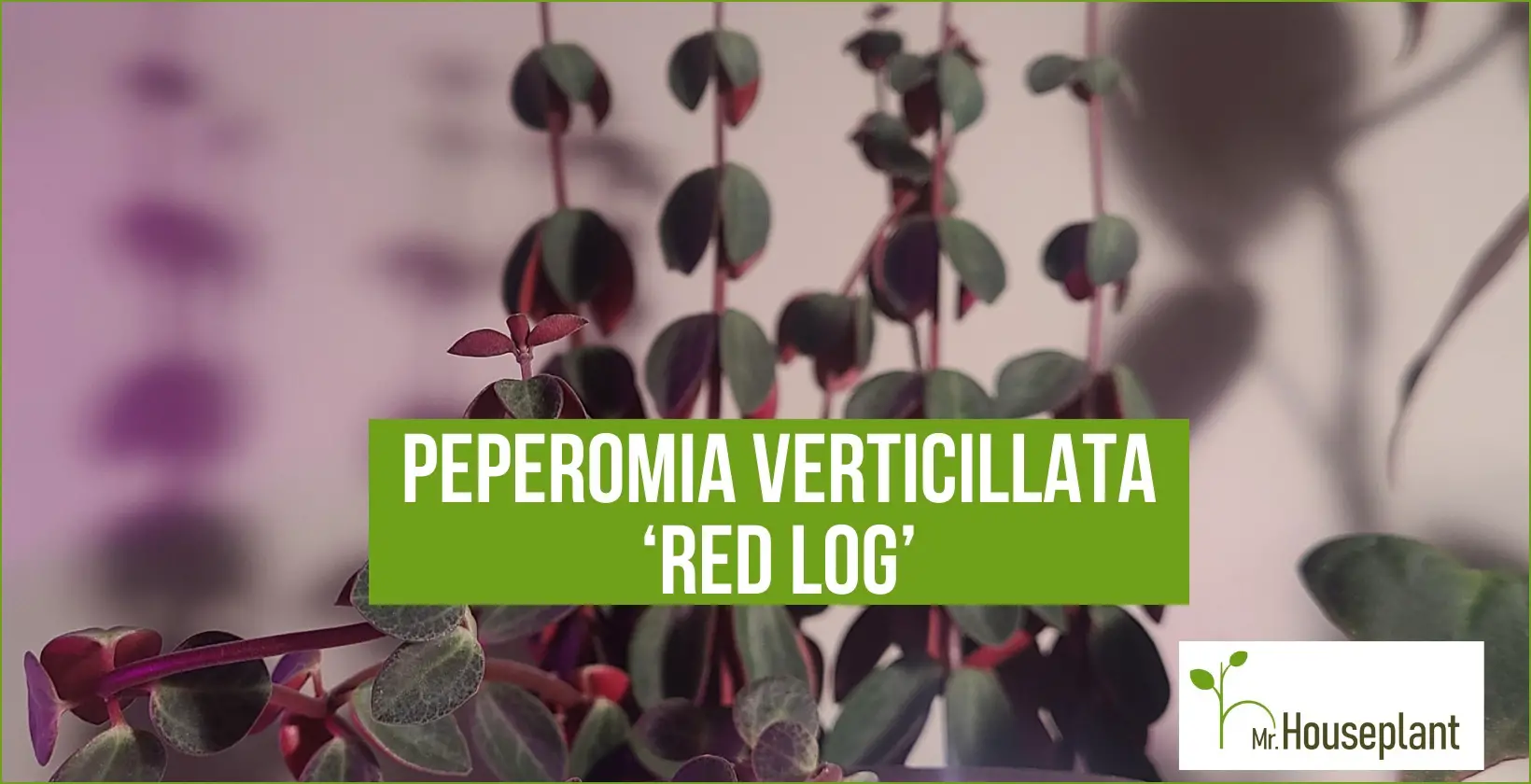
If you want to give your Peperomia Verticillata optimal care so it can thrive, this is the right guide for you. From watering, light requirements, and fertilizing to soil and propagation, this guide has everything you need to be a responsible Peperomia Verticillata parent. Keep reading to get detailed information about growing this captivating plant.
| Botanical Name (Latin Name/Scientific Name): | Peperomia Verticillata |
| Common Name: | Red Log Peperomia |
| Light: | medium light (1,000+ lux; 100 foot candles) |
| Watering: | water once the soil dries out to the bottom of the pot |
| Soil: | well-draining, chunky potting mix |
| Repotting: | once a year or when the roots come out of the drainage holes |
| Fertilizing: | once a month or less often with a high-nitrogen fertilizer |
| Temperature: | temperatures between 65°F to 75°F (18°C to 24°C) |
| Humidity: | 25% to 50%, but it grows well in lower or higher humidity |
| Toxicity for Pets: | non-toxic |
| Toxicity for Humans: | non-toxic |
| Propagation: |
|
| Pruning: | prune dead or diseased growth or when you want the plant to branch out |
What Is Peperomia Verticillata?
Peperomia Verticillata is an evergreen succulent plant. Peperomia Vericillata is a species of Peperomia plants with thick stems with an upright growth habit and green leaves with red undersides. It’s native to Caribbean islands. Its leaves grow in whorls. Red Log Peperomia is often grown as a hanging basket plant.
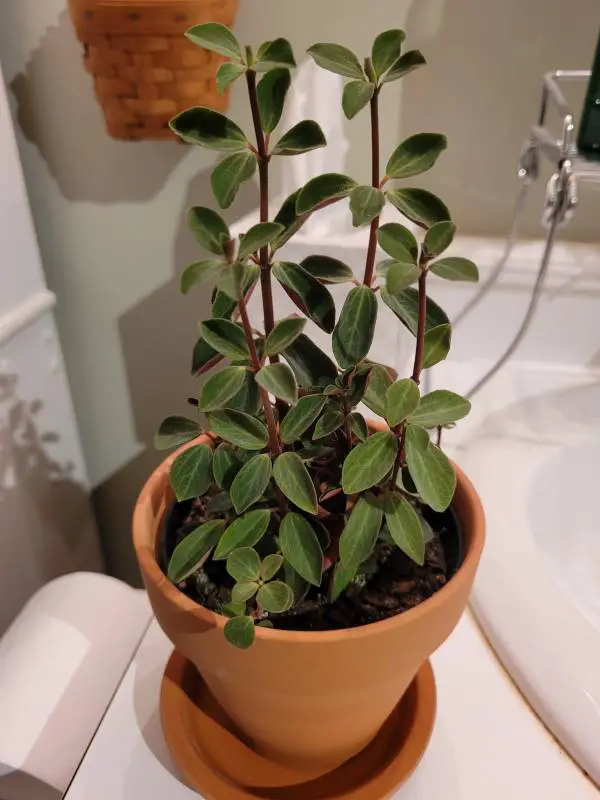
Peperomia Verticillata with its dark green leaves on the topside and red leaves on the underside. Photo of the plant by: tired_MLT
Peperomia Verticillata Care
Peperomia Verticillata care is easy. If you provide your Red Log plant with enough light (more than 1,000 lux), adequate watering, and chunky and well-draining soil, it will flourish and reward you with lush foliage. Peperomia Verticillata Red Log is a great indoor plant for both rooky plant parents and those with more experience.
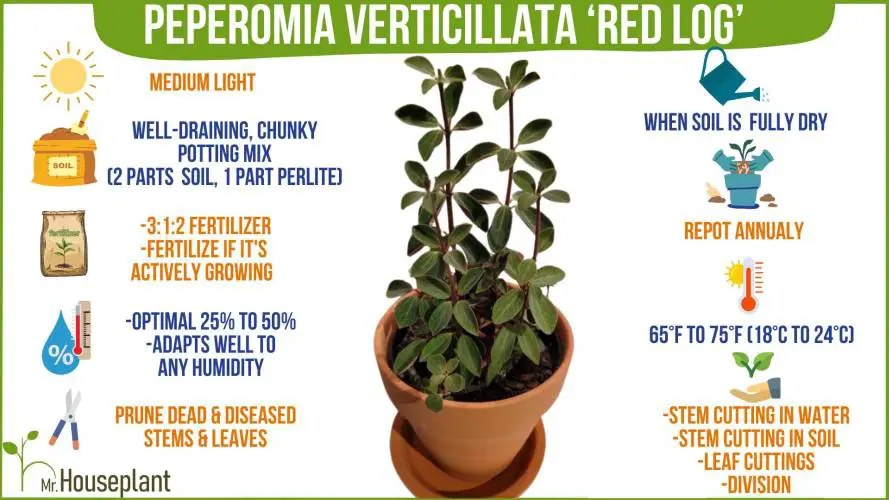
Follow these Peperomia Verticillata care requirements and it will thrive. Photo of the plant by: tired_MLT
Here is a video of Red Log care:
Light Requirements
| Minimal amount of light: | 1,000+ lux (100+ FC) |
| Optimal amount of light: | 2,500+ lux (250+ FC) |
| Direct sun tolerance: | 1-2 hours of early morning or late afternoon direct sun |
| Category: | Medium light |
Peperomia Verticillata does best in bright indirect light (over 3,000 lux / 300+ foot candles). Since Peperomia Verticillata is an understory plant in its native habitat, it is used to medium light conditions and it can tolerate medium light levels. However, it will not thrive in medium light.
Peperomia Verticillata grows well in bright indirect light, but it doesn’t tolerate long exposure to direct sun. Since prolonged exposure to direct sunlight can damage its leaves and affect photosynthesis, it’s best to expose it only briefly to early morning or late afternoon direct sun (no more than 1-2 hours).
Water Needs
The Peperomia Verticillata isn’t a very thirsty plant due to its thick and fleshy leaves. You should let the soil dry out completely before watering. The standard way to assess if your Peperomia Verticillata is thirsty is to use a chopstick. Take a chopstick and stick it all the way to the bottom of the pot. Take it out and if it comes out completely dry, with no soil clinging to it, it’s time to water your Peperomia Verticillata.
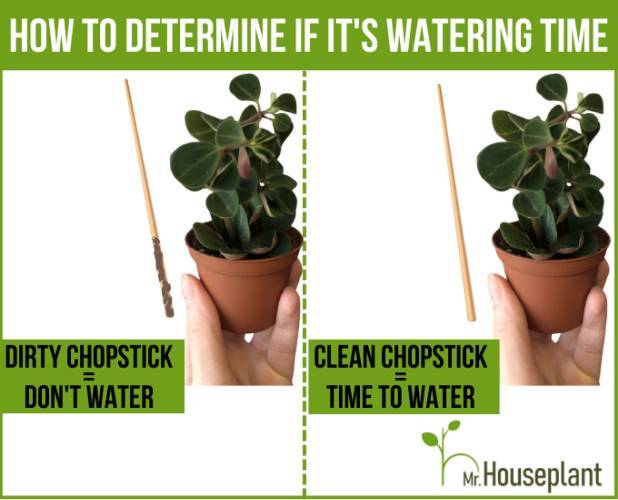
Dirty chopstick means to wait more before watering. Once the chopstick is clean and dry it’s time to water the plant. Photo of the plant by: arcessivi
Peperomia Verticillata tolerates underwatering better than overwatering because of its thick leaves, so be careful not to overwater your Peperomia Verticillata as it will make it more prone to root rot.
Humidity Needs
Optimal humidity levels for Peperomia Verticillata are between 25% and 50%. However, this house plant can adapt well to any humidity level.
Temperature Requirements
Peperomia Verticillata plant, prefers temperatures between 65°F (18°C) and 75F (24°C), according to the University of Georgia Extension, but it will tolerate temperatures down to 55°F (13°C). Make sure to protect your houseplant from cold drafts during winter.
Fertilizing
You can fertilize Peperomia Verticillata during active growth once a month with a liquid fertilizer with a 3:1:2 NPK ratio. Only fertilize your houseplant when it’s actively growing. This way it will be able to absorb and utilize all the nutrients and minerals. Otherwise, the minerals will accumulate in the soil, and the plant won’t be able to use them. This can lead to root damage and subsequently leaf damage.
Always make sure to carefully follow the instructions written on the label, as overfertilizing can damage your Red Log Peperomia.
If you repot your Red Log Peperomia annually, it’s not necessary to fertilize it, since it will get all the nutrients from the soil.
Soil
Peperomia Verticillata will grow well in a well-draining, chunky potting mix. You can make it by mixing 2 parts of store-bought potting soil with 1 part perlite. It’s advisable to use chunky amendments with larger particles as this will create macro pores that contain oxygen. Adequate soil aeration is vital for root health and it helps keep fungal diseases at bay.
Repotting
To repot your Red Log take the following steps:
- Gently take the plant out of its pot
- Loosen the rootball carefully
- Inspect the rootball
- If you notice any dead, smelly, mushy, or diseased roots, cut them off
- Fill up ⅓ of the new pot with fresh soil (mix 2 parts soil with 1 part perlite. Pots with drainage holes are optimal, because the excess water can be expelled)
- Place your Peperomia Verticillata into its new pot
- Fill up the pot with fresh soil
- Gently press the soil around your Red Log
- Wait for the soil to dry out fully before you water
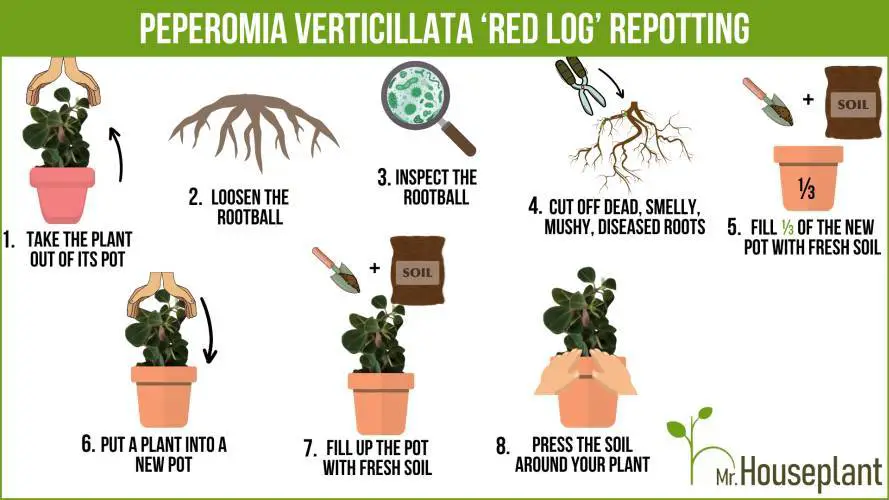
Follow these steps to repot the Red Log plant. Photo of the plant by: arcessivi
You should repot your houseplant if it overgrows its container. You will know this if you see the plant’s roots coming out of the drainage holes. This is a sign that your Peperomia Verticillata needs to be repotted into a one-size larger container so it has room for growth. Even if it doesn’t overgrow its container, you should repot it once a year so it can get nutrients from fresh soil and continue growing in non-compacted soil.
Toxicity To Humans
According to the University of California Poison Control System (CPCS), Peperomia Verticillata Red Log is not toxic to humans.
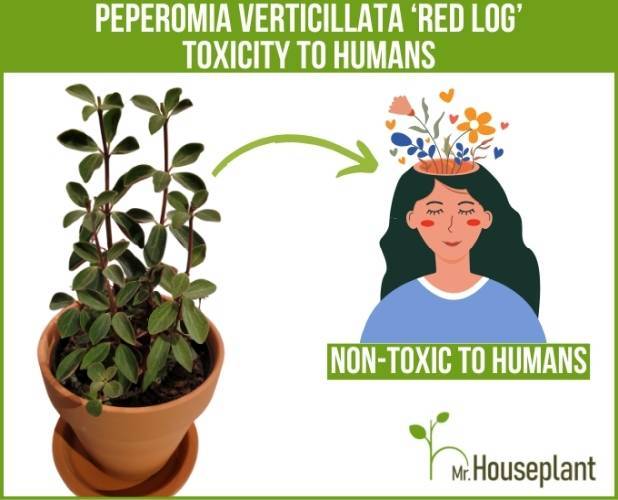
Peperomia Verticillata ‘Red Log’ is not toxic to you and your family. Photo of the plant by: tired_MLT
Toxicity To Pets
Peperomia Verticillata is not toxic to pets according to the American Society For Prevention Of Cruelty To Animals (ASPCA).
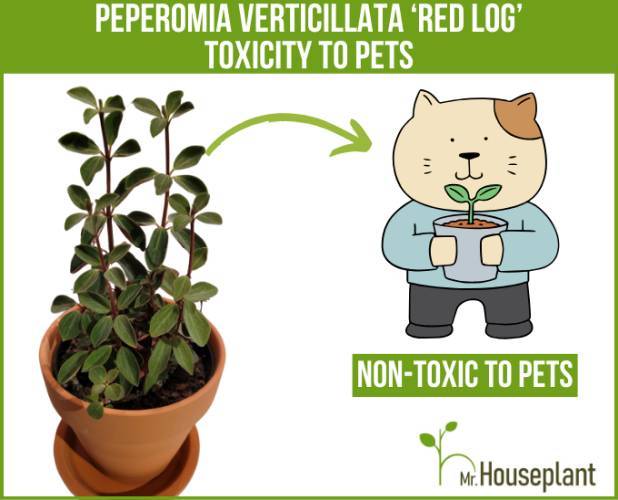
Peperomia Verticillata ‘Red Log’ is safe for your pets. Photo of the plant by: tired_MLT
Pruning
Peperomia Verticillata should be pruned in a couple of scenarios:
- When you want Peperomia Verticillata to branch out and become fuller
- There are dead parts or dry leaves and stems on your plant
- Some plant parts show signs of disease
Always use sterilized and sharp pruning shears to prune your plants. If you want a bushier plant, prune any stem and it will branch out below the cut. To remove dead stems and dry leaves, just prune them off. Finally, it’s crucial to remove all diseased parts of the plant to prevent the disease from spreading further and potentially infecting other plants as well.
Flowering
Peperomia Verticillata produces flower stalks that can be from 5-15″ long. Red Log plant will flower if it gets a sufficient amount of light. Aim to provide over 2,500 lux (250 FC) of light.
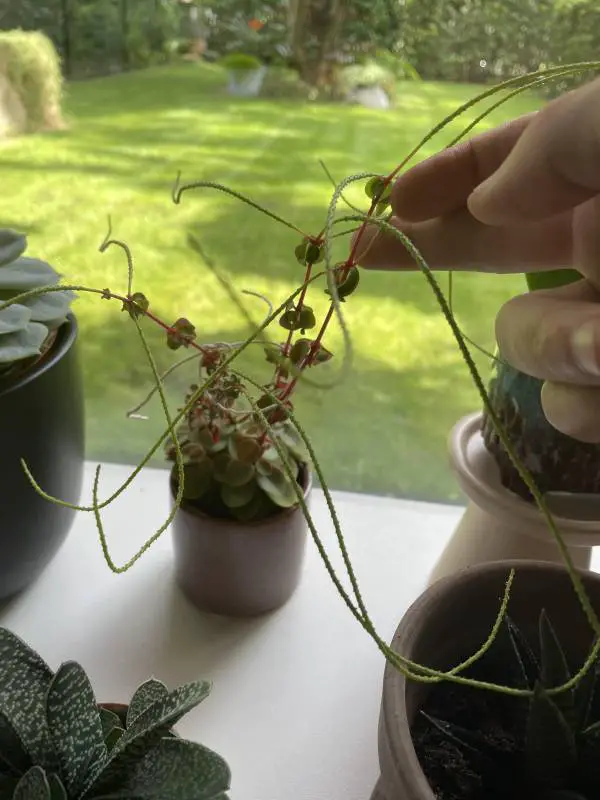
Red Log plant blooming. Photo of the plant by: Coenbrg
Propagation
Red Log Plant can be propagated easily via stem cuttings in water or stem cuttings in soil.
Here is how to propagate them via stem cuttings in water:
- Pick a stem and take a few inches long stem cutting with sharp and sterilized scissors
- If you want to maximize the chances of successful propagation, take a couple of cuttings
- Remove a couple of bottom leaves from the stem so that no leaves sit in water when you place the cutting into a container
- Put the stem cuttings into a glass or another container with fresh water, ensuring that at least 2-3 nodes are in the water
- Put the containers with the stem cuttings in a warm place with bright light
- Check the water periodically and replace it with fresh water once a week, or when it starts to get dirty
- Wait for new growth and when the roots on the stem cuttings reach about 2 inches of length, plant the stem cutting into the soil
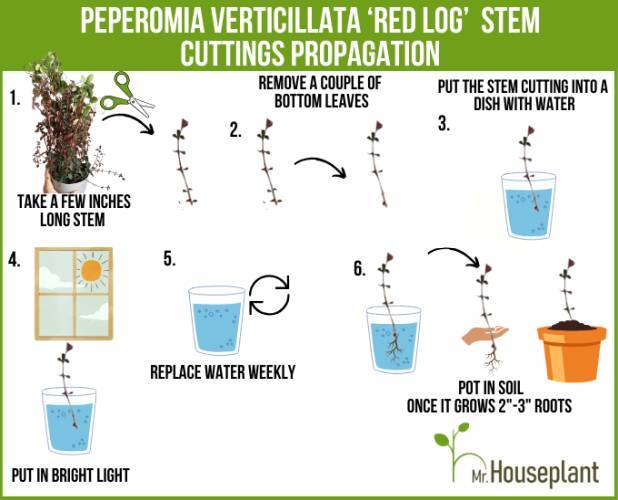
Follow these 6 steps to propagate your Red Log plant. Photo of the plant by: Katerina Mileskaya
Pests
Peperomia Verticillata is susceptible to fungus gnats, mealybugs, spider mites, scales, thrips and caterpillars. In cases of mild infestation with these pests, you can treat your Peperomia Verticillata Red Log with rubbing alcohol, insecticidal soap, or neem oil. In cases of severe infestations, systemic insecticides can be used.
Rubbing alcohol is best against mealybugs. Make a solution consisting of 1 part alcohol and 7 parts water. Spray the plant with this solution making sure that you don’t miss any nooks and crannies since pests like to hide there. Test first on 1 leaf and wait for 24 hours before spraying the whole plant, to make sure there is no damage on the leaf.
Use insecticidal soap against mites. Spray the plant thoroughly, paying special attention to the underside of the leaves. You will usually have to repeat the process a couple of times every 4-7 days, according to the instructions.
In case you want to treat your Peperomia Verticillata Red Log with neem oil, mix 5 drops of pure 100% neem oil with 5 drops of dish soap in 16oz of water. Use a spray bottle to spray the plant with this solution. Keep the plant out of the direct sun for a few hours after the application, as the direct sun can cause leaf damage after neem oil application.
Diseases
The most common diseases affecting the Red Log Peperomia are:
- Cercospora leaf spot
- Phytophthora and Pythium stem and root rot
- Sclerotium stem rot
- Phyllosticta leaf spot
- Rhizoctonia leaf spot
These diseases are fungal. You can prevent them by keeping the plants’ leaves dry and out of contact with potting soil. Overhead watering and wetting of the foliage can also contribute to susceptibility to fungal infections. Keep the leaves dry to avoid these diseases.
If the diseases occur, cut off and discard the infected leaves and use a fungicide spray to keep the infection from spreading on you Peperomia Verticillata. However, when the symptoms occur, it’s usually difficult to save the plant. Your best bet is to prevent the disease by keeping the leaves dry.
Common Problems
Leaves Turning Yellow
Peperomia Verticillata Red Log can have yellow leaves due to multiple possible reasons: improper watering (overwatering or underwatering), lack of light, pests, or nutrient imbalance. Address every possible factor accordingly: make sure your watering schedule is optimal, and give your plant enough bright, indirect light, but don’t overdo it with direct sun. Check for signs of pests and treat them with control methods.
Fertilize your Peperomia Verticillata once a month or less often and ensure that you’ve done so according to the instructions on the package.
Leaves Curling
Inadequate light, improper watering, and pests (mites particularly) can cause the leaves of the Peperomia Verticillata to curl. Regulate how much light and water your plant gets, and treat the mites infestation with insecticidal soap or neem oil.
Brown Leaves
Red Log Plant can have brown leaves due to sunburn, underwatering, nutrient imbalance, or fungal infections (leaf spot). Avoid exposing your Peperomia Verticillata to direct sunlight for more than 1-2 hours, make sure to water the plant when the soil has dried out completely, fertilize the plant only when it’s actively growing to avoid nutrient accumulation in the soil and prevent and treat the fungal infections with a fungicide.
Conclusion
Peperomia Verticillata is an easy-to-grow plant if you ensure to meet its care requirements. If you apply all the tips and trick from this care guide, you will certainly be a proud plant parent of a lush and healthy Peperomia Verticillata.
Yours Truly,


Related Posts
Sansevieria Black Gold (Snake Plant Care GUIDE!)
Spathiphyllum Sensation (FULLY Explained!)
Alocasia Stingray Care